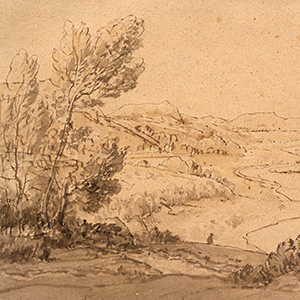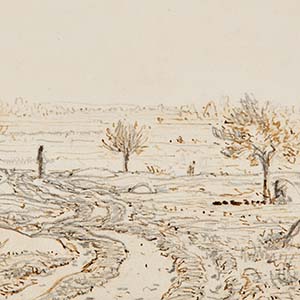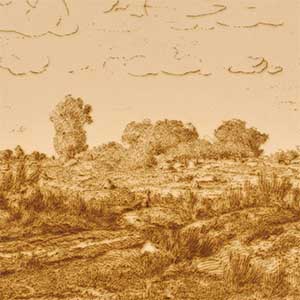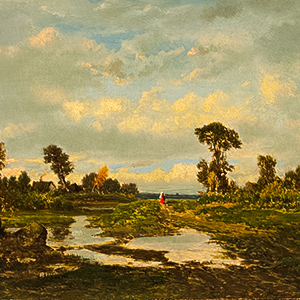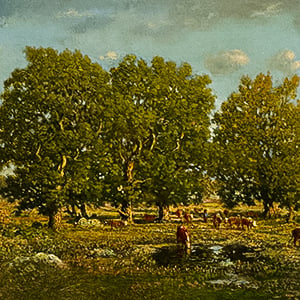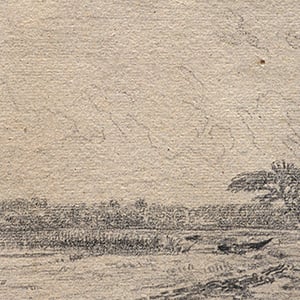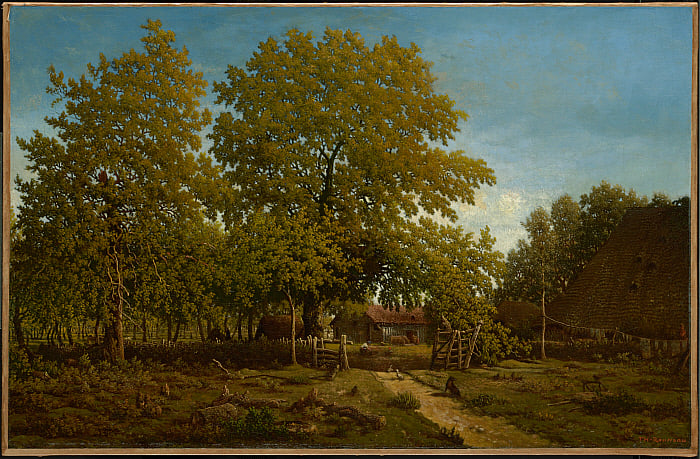
Théodore Rousseau
French, 1812–1867
Farm in the Landes
c.1852-67
In the summer of 1844, Rousseau visited the remote region of the Landes in southwestern France. There he made a pencil sketch of a farm shaded by towering oak trees and later produced a more detailed oil study of the scene. He developed this painting from the preparatory sketch and study, working on it intermittently over the next twenty years. The meticulous detail and high finish reflect Rousseau’s extended working process and his desire to present a timeless vision of the ideal coexistence of human beings and nature in this rural setting.
| Medium | oil on canvas |
| Dimensions | 25 1/2 x 39 in. (64.8 x 99.1 cm) Frame: 36 1/2 × 49 3/16 in. (92.7 × 124.9 cm) |
| Object Number | 2009.8 |
| Acquisition | Acquired by the Clark, 2009 |
| Status | On View |
Image Caption
Théodore Rousseau, Farm in the Landes, c.1852-67, oil on canvas. Clark Art Institute, Acquired by the Clark, 2009.8
Select Bibliography
EUROPEAN PAINTINGS CATALOGUE ENTRY
Provenance
The artist (sold to Hartmann, Feb. 1852); Jacques-Félix-Frédéric Hartmann, Münster and Paris (1852–d. 1880, his sale, 18 rue de Courcelles, Paris, 7 May 1881, no. 16, ill. [print by Masson after the painting], sold to or bought in by Julie Hartmann); Julie Hartmann (Julie-Aimée Sanson-Davillier), his wife (1881–1907, sold to Brame, 24 Dec. 1907); [Galerie Brame, Paris, 1907–9, sold to Baillehache, 6 May 1909]; Alfred Baillehache (from 1909); vicomte de Curel, Paris (his sale, Galerie Georges Petit, Paris, 3 May 1918, no. 16, as La Maison du garde, possibly sold to Gerard);¹ L. Tauber, Paris (by 1938–d. before 1945); Baveret, Paris, by descent from Tauber (from c. 1945);² private collection, Paris; private collection, Portugal (sale, Christie’s, London, 26 June 2007, no. 206, sold to Matthiesen); [The Matthiesen Gallery, London, 2007–9, sold to the Clark, 30 Sept. 2009]; Sterling and Francine Clark Art Institute, 2009. 1. The 1918 sale has been identified as the collection of Marie-Albert, vicomte de Curel (1827–1908). See online information from the National Gallery of Art, Washington, which owns three paintings from his collection. The owner up to 1918, however, has been identified by the Matthiesen Gallery as François, vicomte de Curel (1854–1928), Marie-Albert’s son. This suggests that Marie-Albert never owned the painting, but that François de Curel included it in the 1918 sale of his father’s collection. Note that the sale was postponed from 3 May to 25 Nov. 1918. 2. Tauber lent this painting to the exhibition organized by the French government in 1939 that traveled to South and then North American museums (Buenos Aires and others 1939–46). Tauber died before the end of World War II, and when the painting returned from Washington, it was restituted to his heir, Monsieur Baveret. For further details see Matthiesen Fine Art, Théodore Rousseau: A Magnificent Obsession; La Ferme dans les Landes ou La Maison du Garde, 2009.

